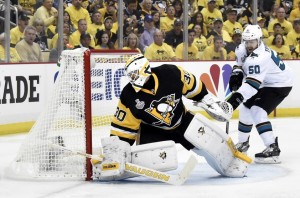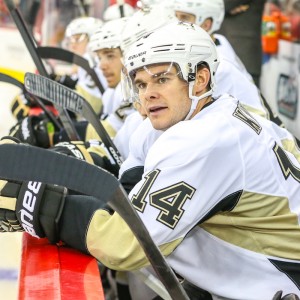With as fast-paced and successful as the Pittsburgh Penguins have played since their mid-season makeover, many are picking the Penguins to win back-to-back Stanley Cups for the first time since Detroit won it twice in a row during the 1990’s.
But even as those believers see their numbers rise almost by the day, there’s a notion which simply must not be ignored: repeat Cup championships aren’t exactly easy to accomplish, no matter who you are. Sure, there are plenty of arguments that these believers can make. Perhaps their most convincing point is that this Pens team will see the return of practically their entire playoff roster for the upcoming 2016-17 season.
The Pens are fortunate enough to have only lost three members of their run to Stanly Cup glory. Ben Lovejoy is now a New Jersey Devil, as is Beau Bennett, who didn’t actually play a significant role in the playoffs. Then there’s Jeff Zatkoff who is on his way back to the team who originally drafted him; the Los Angeles Kings. Losing only role players after a winning a championship is a fantastic way to begin an attempt at a repeat. There are other factors, though, which will make a repeat championship all the more difficult this season.
Is Matt Murray as Advertised?
THW writer Mark Shiver recently published an article “Repeat for Penguins Probable” where he discusses factors which work in the Pens’ favor that may lead them to another Stanley Cup championship in the year ahead. You should read that, then read on as I contrast points in his excellent article.

Shiver’s first point involves the goaltenders, Matt Murray and Marc-Andre Fleury. He notes that when Fleury was injured Murray stood tall and never relinquished his grasp on the starting role. That certainly was the case during the playoffs. However, the goaltending situation has now become the “topic du jour” in Pittsburgh after it has been reported that Fleury will be given the opportunity to compete for the number one job during camp. This stage is set for these two to battle it out for the number one job in Pittsburgh’s crease.
To expound a bit more upon the goaltending situation, there’s a possibility that Murray may be more undeveloped than currently perceived. Toward the beginning of the playoffs, Murray played with conviction and really owned his crease. Some time after the Washington series, though, the Pittsburgh defense galvanized in front of him drastically lowering the average shots faced from about thirty-two per game to little over twenty-four per game. Credit the defense, because that stat played a huge part in the team’s success as Murray appeared to fatigue during the latter portion of the playoffs.
Whether it was fatigue or something else, Murray simply didn’t look quite as sharp after the Washington series. That’s not to say that he was a goaltending disaster – he was far from it. He just appeared to weaken slightly as the playoffs progressed. Murray showed repeated tendencies to play too deep in his own net, which thankfully didn’t burn him nearly as often as I thought it might. However lucky he might have been in that regard, luck didn’t stick with him when he would repeatedly go down a bit too early. San Jose capitalized on this a few times; once during game three and again in game five of the Cup Final. Even after those two nearly identical goals were scored, Murray showed little enthusiasm for correcting that issue. Credit the defense again for getting stick-on-puck and bodies in front of shots which allowed Murray to survive his flaw for the remainder of the Cup final.
Joonas Donskoi Overtime Winner, Stanley Cup Final, Game 3
Brent Burns First San Jose Goal, Stanley Cup Final, Game 5
Even if Murray’s flaws are corrected, he still needs to hold off a determined Marc-Andre Fleury. Fleury, who is coming off of his best regular season performance, isn’t ready to concede anything to Murray. Robert Laflamme quoted Fleury in his recent article.
I had some good conversations with management after the season. Nothing is written in stone. I want to come to camp ready to win my job back. I have to get back to the same level of play and help the team, win games.
Boys to Men
Another colleague of mine, Greg Thornberry makes an excellent point in his recent article “Penguins’ Musings: Murray, Sundqvist, Top-Six” (I strongly encourage you to read it.) regarding the top-six forwards. For a Stanley Cup champion team entering it’s “repeat year”, it only has one true line with any degree of certainty. That’s the HBK line (Carl Hagelin, Nick Bonino, Phil Kessel).

(Adam Hunger-USA TODAY Sports)
Linemates for those other lines aren’t exactly a mystery, either. One-way contracts were handed out to the likes of Bryan Rust, Scott Wilson and Tom Kuhnhackl ensuring they’ll be a part of the team and will occupy roles on the first, third or fourth line (HBK operates as the second line). Scott Wilson looked sharp during limited action, but he’s injured and considered to be out long-term. Both Rust and Kuhnhackl were impressive in the playoffs and played with a much-needed infusion of youthful energy. But can they keep it up? The untimely “sophomore slump” is always a concern, especially considering these young men will play alongside teammates who themselves have generated a fair amount of recent criticism.

Chris Kunitz, a player whose hands nearly disintegrated a few years ago had a surprisingly resurgent season. Evgeni Malkin played at nearly a point-per-game pace, a far cry from the one hundred point campaigns we’re used to seeing. With both players now occupying roles on the third line, will Bryan Rust’s presence be enough to help both Kunitz and Malkin meet our expectations as a scoring line? Or will Kunitz, in his thirteenth season and at age thirty-seven (in September), prove that last season was merely the “Indian Summer” in the twilight of his career?
And how will twenty-three-year-old Conor Sheary be used? For a player who amassed ten points in twenty-three playoff games mostly as a top-six forward, he’s heading into the season without a clearly defined role. Let’s remember, it was he who played the role of overtime hero during game two of the Stanley Cup Finals. In the past, the Pittsburgh media has criticized him due to his size. (he’s listed as five foot, eight inches tall on the Pittsburgh Penguins official site.) Diminutive as he may be, he’s proven to be skilled enough to handle the puck on a line with Sidney Crosby. That’s no small feat. Earning Sid’s trust certainly gives head coach Mike Sullivan more roster flexibility as Sheary can move into and out Crosby’s line Can he continue to draw comparisons to players like Tyler Johnson or even Martin St. Louis? And will he continue to slot in alongside Crosby and Patric Hornqvist? Or will a Stanley Cup hero be relegated to a depth player as a regular healthy scratch?
Conor Sheary Overtime Goal, Stanley Cup Final, Game 2
Other Contributing Factors
Helping to compound things not just for the Pens, but for the entire league is the compacted schedule necessitated by the upcoming World Cup of Hockey. The last time the NHL instituted a schedule so rigorous, it was a result of the lockout of 2012-13. Playing at a pace of a-game-ever-other-day is going test the club’s depth. Expect more players to be used and expect those players to experience growing pains as they rotate in with new linemates. Keeping aging veterans like Matt Cullen and the aforementioned Kunitz fresh should be a priority heading into the regular season. The Pens play a fast paced game. The phrase “speed kills” can work in both directions. There are going to be a lot of exhausted hockey players at the Consol Energy Center when Spring arrives.
If the playoffs taught us anything, it’s that the Penguins’ lineup is capable of winning no matter how things shake out. Line combinations were juggled a bit, with varying degrees of success. Questions regarding production won’t be directed towards players like Rust, Wilson, Kuhnhackl or Sheary. Answers to those questions will be found in their potential linemates. The aging veterans must continue to keep pace with their younger brethren. The road to a repeat championship hasn’t been this difficult in some time. Playing energetic, inspired hockey won them a Stanley Cup. It remains to be seen if that high level of effort can be sustained over the course of eighty-two games with the added distraction of a goaltending controversy. If the Pens are to make good as the odds-on favorite in their hunt for a repeat championship, they must pace themselves or risk being burned out by the season’s end.